Seating Arrangement: Meaning, Reasoning Questions with Answers, Tricks
The seating arrangement reasoning is categorised as an important topic in logical reasoning. It is asked in almost all government and entrance exams such as CAT, MAH MBA CET, CUET, Banking, SSC, Defence, Insurance, etc. In such questions, you must arrange the persons/things or any given elements to certain satisfying conditions. The questions on the topic can be asked in any sequence, such as table-based arrangement, linear/circular arrangement, rectangle or square-based arrangement, polygonal-based arrangement, etc. In this article, we will cover types of seating arrangements, linear seating arrangement reasoning, square seating arrangement reasoning, circular seating arrangement reasoning, seating arrangement reasoning tricks, seating arrangement reasoning questions and answers to seating arrangement reasoning questions for bank PO, etc. As the MAH MBA CET is approaching, students can attempt the latest Free Mock Test designed for the aspirants by our experts to score a high percentile in the exam.
CAT 2024: 20 Free Mock Test | 10 Year PYQs | 60 Day Study Material | Most Scoring Concepts
XAT 2025: Section-wise Preparation Tips | Sample Paper
Don't Miss: IBSAT 2024 Mock Tests | NMAT 2024 Sample Papers | MAT 2024 Sample Papers
Question with Solutions: Missing Number | Alphabet Test | Arithmatical Problems | Calendar
- Types of Seating Arrangements
- Table-based Puzzle
- Linear/Circular Arrangement
- Rectangle or Square-based Arrangement
- Overview of Rectangle/Square-based Arrangements
- Solved examples of Seating Arrangement

Types of Seating Arrangements
1) Table-based arrangement
2) Linear arrangement
3) Circular arrangement
4) Rectangle/Square-based arrangement
5) Triangle-based arrangement
Table-based Puzzle
Table-based puzzle questions are asked in almost every government exam. In table-based puzzles, you have to extract the data from the given information to arrange the persons/ things accordingly. These puzzles are also based on the seating arrangement. You have to arrange the data either in the form of rows or in the form of columns.
Understanding Table-based Arrangements
To understand the table-based arrangements you should be good at analysing and extracting the data from the given information. Table-based arrangements play an important role in the logical reasoning section as one table consists of a set of 4-5 questions and you can score well in the exam after solving one table.
Strategies for Solving Table-based Puzzles
1) First of all, don’t read the complete information given in the question. Start from the beginning and start writing notes to record minute information as well which helps you further in creating a table or solving the puzzle easily.
2) After reading some of the information you have to decide how to arrange the persons or objects either in rows or in columns this helps to solve the puzzle easily and in less time.
3) Practice is key to success. Practising a variety of table-based puzzles helps you to understand better and you can extract the data easily from the given information.
Example:
Directions: Five friends K, L, M, N, and O play one of five different sports Cricket, Football, Hockey, Badminton, and Volleyball. Each friend plays only one sport. L and M do not play Hockey and Badminton. K plays Cricket. M does not play Volleyball. O does not play Badminton. Who plays Volleyball?
1) L
2) Either L or O
3) N
4) Either L or N
Solution:
Given:
I. L and M do not play Hockey and Badminton.
II. K plays Cricket. M does not play Volleyball.
III. O does not play Badminton.
According to the given instructions figure is given below.
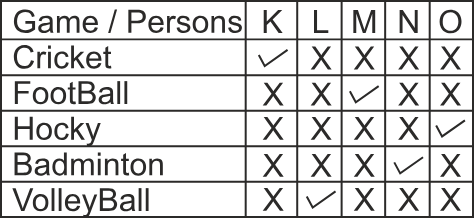
So, L plays Volleyball. Hence, the first option is correct.
Example:
Directions: Each of A, B, C, D, E, F and G has an exam on a different day of the week starting on Monday and ending on Sunday of the same week. A has an exam on Wednesday. Only one person has an exam between A and B. D has an exam on the day immediately before B. Only one person has an exam between F and B. G’s exam is on one of the days before A but on one of the days after C. On which day does G have an exam?
1) Friday
2) Tuesday
3) Monday
4) Wednesday
Solution:
Given:
A has an exam on Wednesday. Only one person has an exam between A and B. D has an exam on the day immediately before B. Only one person has an exam between F and B. G’s exam is on one of the days before A but on one of the days after C.

From the final arrangement, G has the exam on Tuesday. Hence, the second option is correct.
Linear/Circular Arrangement
Linear and circular arrangements are both different types of arrangements. In linear arrangements, persons/ objects/ elements are arranged in rows or columns facing directions such as North, South, East, and West. In the circular arrangement, persons are arranged in a circular table facing towards the centre or facing away from the centre it may be any number of persons according to the exam's trend minimum arrangement of six persons is given and a maximum twelve number of persons is given.
Let’s understand the types of linear and circular arrangements.
Basics of Linear Arrangement
Linear Arrangements are basically of two types:-
1) Single-row linear arrangement:- In this type, persons are sitting in a single row facing a specific direction or persons facing opposite directions as mentioned in the given question.
2) Double-row linear arrangement:- In this type, persons are sitting in two rows facing the same direction or facing the opposite directions as mentioned in the given question.
Solving Techniques for Linear Arrangements
1) To solve linear arrangements first of all students should read the question carefully and then determine the rows that in how many rows they have to arrange the persons.
2) The students should be very clear about the left and the right sides of the row as it allows the students to arrange the persons in a row easily.
3) To arrange the persons in a row students should check the left and the right sides of the rows with their hands. For
Example:- The persons facing the north row the left side of the row is in the west direction and the right side of the row is in the east direction. Check the position of your hands. Similarly, when the person facing the south direction the left hand is in the east direction and the right hand is in the west direction of the south with the position of hands you can know about the left and right sides. As the sides play a vital role in the arrangement of persons.



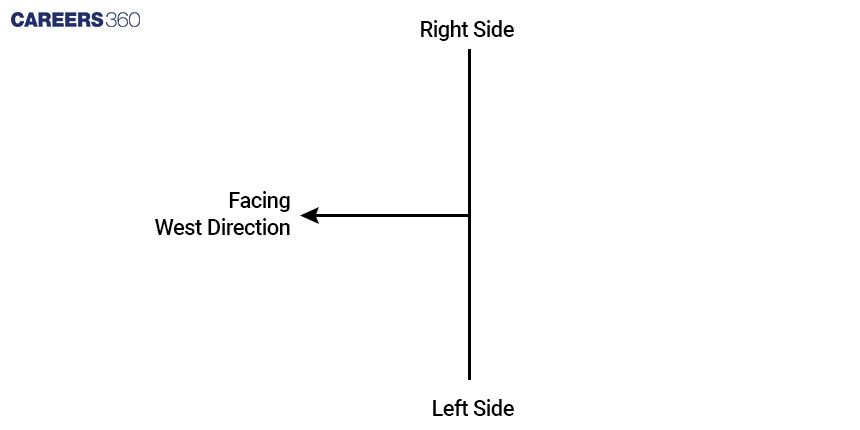
4) In the linear arrangement, if C is four people away from E, then 4 - 1 = 3 people will sit between them.
5) Practice is key to success. By practising more and more questions you can solve the simple linear arrangement questions visually.
Example:
Directions: Five houses K, L, M, N, and O are situated in a row, all facing the north. M is to the immediate left of L. K is between O and M. N is third to the right of K. Which house is exactly in the middle?
1) K
2) L
3) M
4) N
Solution:
Given:
I. M is to the immediate left of L.

II. K is between O and M. N is third to the right of K.

So, M is in the middle. Hence, the third option is correct.
Example:
Directions: Out of the six members of a panel sitting in row E is to the left of B but on the right of A. F is on the right of B but is on the left of G who is to the left of C. Find the members sitting right in the middle.
1) A E
2) B F
3) G C
4) F G
Solution
Arrange all the persons according to the instructions to determine their positions.
Given:
Let all the members face in the north direction.
(I) E is to the left of B but on the right of A.

(II) F is on the right of B but is on the left of G who is to the left of C

So, B and F are in the middle. Hence, the second option is correct.
Example:
Directions: Eight people are sitting in two parallel rows with 4 people each in such a way that there is equal distance between adjacent persons. P, Q, R, and S are seated in the same row facing south. L, M, N, and O are seated in the same row facing north. L sits to the extreme left of the row and faces R who sits exactly opposite him. P sits second to the left of R and is exactly opposite O. M sits at the extreme right of their row and is exactly opposite S. Who sits exactly opposite Q?
1) L
2) M
3) N
4) O
Solution:
Given:
(I) L sits to the extreme left of the row and faces R who sits exactly opposite him. P sits second to the left of R and is exactly opposite O.
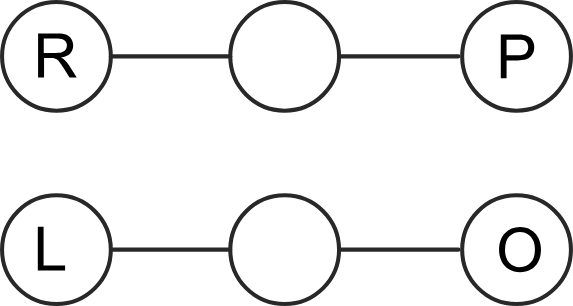
(II) M sits at the extreme right of their row and is exactly opposite S.
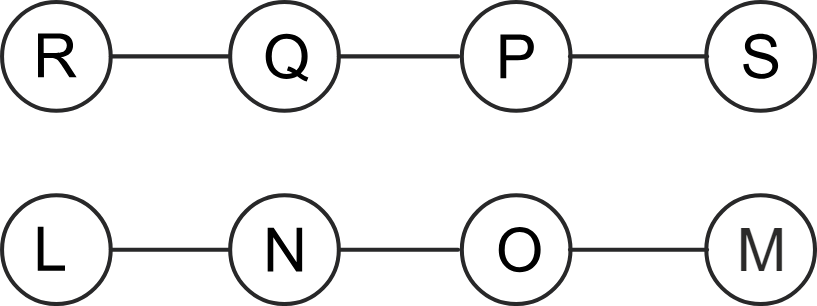
So, N sits exactly opposite Q. Hence, the third option is correct
Example:
Directions: Seven students A, B, C, D, X, Y and Z are sitting in their classroom facing in the southern direction. A and D do not sit together. Z sits second to the left of X. B does not sit with Z. X is fourth to the right of C. A and B are not sitting together. C sits in between D and Y Y sits second to the left of the one who sits second to the left of B. Who sits at the extreme ends?
1) B and D
2) C and Y
3) Z and X
4) A and B
Solution:
Given:
(I) Z sits second to the left of X. X is fourth to the right of C

(II) A and D do not sit together. B does not sit with Z. A and B are not sitting together. C sits in between D and Y. Y sits second to the left of the one who sits second to the left of B.

So, according to the arranged students B and D are at extreme ends. Hence, the first option is correct.
Understanding Circular Arrangement
The circular arrangement questions play a most important role in the logical reasoning section. It is seen in all examinations whether they are competitive exams or entrance exams. A circular arrangement is defined as an arrangement of persons/ objects/ elements in a circular form such as on a circular table or in a circle. It is basically of two types.
1) The persons facing towards the centre:- In this type, persons are sitting in a circular arrangement facing towards the centre. It is easy to solve as in this type of question the left side of the person is arranged in a clockwise direction and the right side of the person is arranged in an anticlockwise direction. You should check the left and right sides of the person according to your hands.
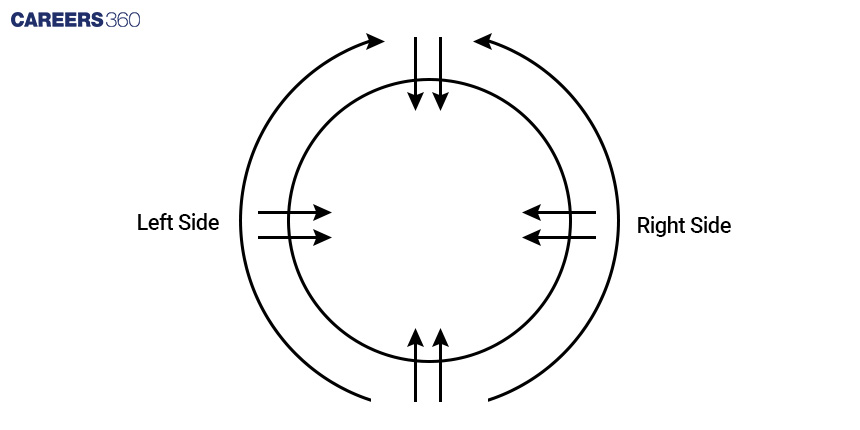
2) The persons facing away from the centre:- In this type, persons are sitting in a circular arrangement facing outside/away from the centre. It is easy to solve as in this type of question the left side of a person is arranged in an anticlockwise direction and the right side of a person is arranged in a clockwise direction. You should check the left and right sides of the person according to your hands.
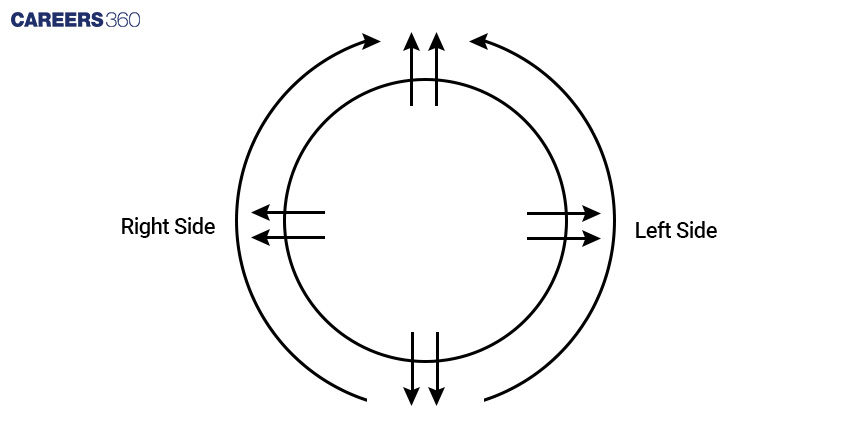
Example:
Directions: A, B, C, D, E, and F are standing in a circle talking, facing the centre of the circle. E is standing immediately right of C. D is standing at the third position towards the left of C. A is standing at the second place towards the right of F. Who is standing to the immediate right of D?
1) B
2) E
3) C
4) A
Solution
Given:
(I) A, B, C, D, E, and F are standing in a circle talking, facing the centre of the circle.
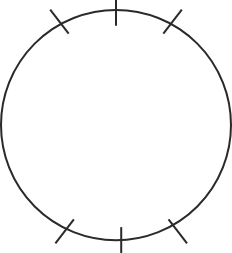
(II) E is standing immediately right of C. D is standing at the third position towards the left of C. A is standing at second place towards the right of F.
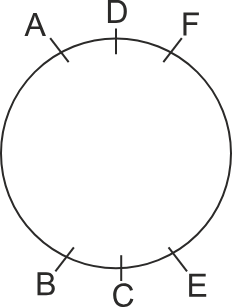
So, A is standing to the immediate right of D. Hence, the fourth option is correct.
Example
Directions: Five friends M, N, O, P and Q sit around a circular table facing away from the centre. O is sitting to the immediate left of P who sits third to the right of Q. M does not sit adjacent to P. Who sits to the immediate right of P?
1) N
2) Q
3) O
4) M
Solution
Given:
(I) Five friends M, N, O, P, and Q sit around a circular table facing away from the centre. O is sitting to the immediate left of P who sits third to the right of Q.
(II) M does not sit adjacent to P.
From the above-given information, the following seating arrangement can be drawn –
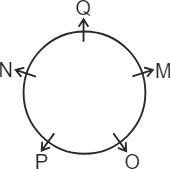
So, N sits to the immediate right of P. Hence, the first option is correct.
Approaches to Solving Circular Arrangements
1) First of all read the information carefully given in the question, count the number of persons given and draw the circle accordingly.
2) As the types of circular arrangement mentioned above draw the circle facing towards or facing outside the centre accordingly.
3) For ease, mention the left and the right side with arrows at the top or bottom of the circle to avoid any confusion.
4) A systematic approach will help you to solve the questions easily and quickly.
Rectangle or Square-based Arrangement
The rectangle or square-based arrangement is one of the most important topics in seating arrangement as it is asked in almost all competitive exams as well as entrance exams. In these types of questions, people are seated on a rectangular or a square table. There are two types of rectangle or square-based seating arrangements which are as follows:
1) People are seated at the corners and some are seated at the centre of the line facing towards the centre.
2) People are seated at the corners and some are seated at the centre of the line facing away from the centre.
Overview of Rectangle/Square-based Arrangements
Rectangle /square-based arrangements are defined as an arrangement of persons/ objects on a rectangular or square table. Generally, eight or six persons are seated for questions seen in the exam. In which half persons are seated at the corners of the line and the rest are seated at the centre of the lines. You have to read the information carefully to arrange the person correctly. The arrangement is done according to the circular arrangement but you have to be careful about the corners and the centre of the lines.
Solving Strategies
1) First of all, read the entire information carefully given in the question. You should write down the information or keep it in mind till the puzzle has been solved.
2) Don’t be scared by the language and the length of the question.
3) Determine all the possibilities which may be as per the given information. In the end, all possibilities will be cancelled and you can solve the final seating arrangement.
4) Practice several questions to ace the topic.
Example:
Directions: Four friends are playing carrom and sitting on the four sides of the carrom board. B is to the right of C. D is to the left of A. Who is sitting to the left of C?
1) Data is inadequate
2) A
3) D
4) B
Solution:
Given:
(I) Four friends are playing carrom and sitting on the four sides of the carrom board.
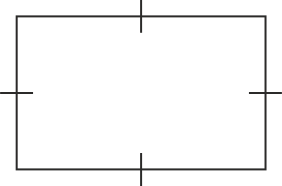
(II) B is to the right of C. D is to the left of A.
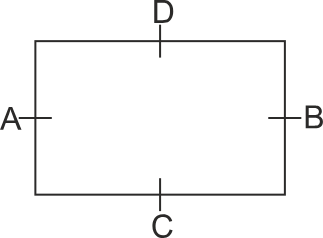
So, A sits immediately left of C. Hence, the second option is correct.
Example:
Directions: 6 boys B1, B2, B3, B4, B5, and B6 are sitting around a rectangular table facing toward the centre (not necessarily in the same order). Two boys are sitting on each longer side and one boy is sitting on each shorter side of the table. B1 sits second to the left of B6. B4 sits second to the left of B5. B5 is the immediate neighbour of B6 and B2. B5 is not sitting opposite to B4. B1 is not sitting on a shorter side.
Which pair of boys are sitting on the shorter side of the rectangular table?
1) B1 and B4
2) B4 and B2
3) B2 and B3
4) B6 and B3
Solution:
Given:
(I) 6 boys B1, B2, B3, B4, B5, and B6 are sitting around a rectangular table facing towards the centre (not necessarily in the same order). Two boys are sitting on each longer side and one boy is sitting on each shorter side of the table. B1 sits second to the left of B6.

(II) B4 sits second to the left of B5. B5 is the immediate neighbour of B6 and B2.
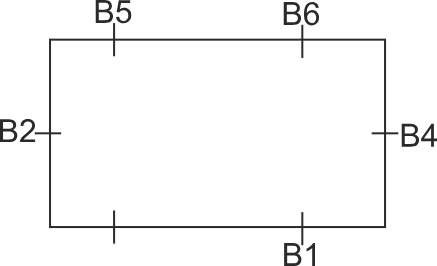
(III) B5 is not sitting opposite to B4. B1 is not sitting on a shorter side.
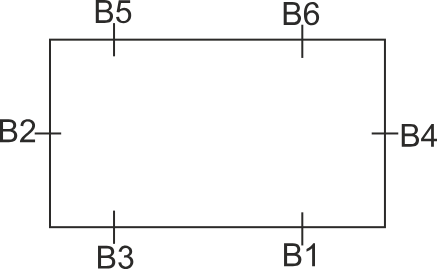
So, B2 and B4 sit on the shorter side. Hence, the second option is correct.
Triangle-based Arrangement
In a triangle-based arrangement, persons are arranged or seated around a triangle. It depends on the information given in the question that persons are seated either on the edges or on the sides or both sides and edges. The triangle-based arrangement is of two types which are as follows:
1) Persons seated around the triangle face towards the centre:- In the triangle in which persons are seated facing towards the centre right side means in an anti-clockwise direction and the left side means in a clockwise direction.
2) Persons seated around the triangle face outside the triangle:- In the triangle in which persons are seated facing outside the centre right side means a clockwise direction and the left side means an anticlockwise direction.
Introduction to Triangle-based Puzzles
Triangle-based puzzles are a new trend puzzle are mostly seen in banking exams such as IBPS PO, Clerk, RRB, SBI PO etc. In this type, you have to arrange the persons in the triangular form either on the edges or on the sides or both edges and sides. It depends on the form of the question. Here, in triangle-based puzzles, the technique is the same as used in the circular or rectangle/ square-based puzzle arrangement. You have to consider the left and the right side of the person very carefully as mentioned above. The example below is similar to the questions for seating arrangement reasoning questions for the SBI PO exam.
Example:
Directions: Study the following information carefully and answer the below questions.
Q 1-3) Nine persons- A, B, C, D, E, F, G, H and I are sitting on the triangular table but not necessarily in the same order. Two of them sit on each side of the triangular table and three of them sit on the corner of the triangular table. The persons who sit in the corner are facing away from the centre of the table and the persons who sit in the middle of the table are facing towards the centre of the table. The consecutive alphabetically named persons are not sitting together. C sits second to the left of I. Only two persons sit between I and H. H sits immediately left of F, and vice versa. Not more than one person sits between I and F when counted from the right of F. B sits second to the left of E, and vice versa. The number of persons sitting between B and H is the same as the number of persons sitting between C and A when counted from the left of C and right of B. The number of persons sitting between D and F is the same as the number of persons sitting between G and D.
Q-1) If D is related to H and B is related to I in a certain way. Then who among the following is related to G?
1) C
2) E
3) The person who sits immediately right to A
4) The person who sits immediately left of F
Q-2) Who among the following people sits at the corner of the table?
1) C
2) One who sits to the immediate right of H
3) One who sits second to the left of I
4) G
5) A
Q-3) What is the position of A with respect to C?
1) Second to the left
2) Second to the Right
3) Third to the right
4) Fourth to the right
5) Immediate left
Solution:
There are two possibilities according to the above information:
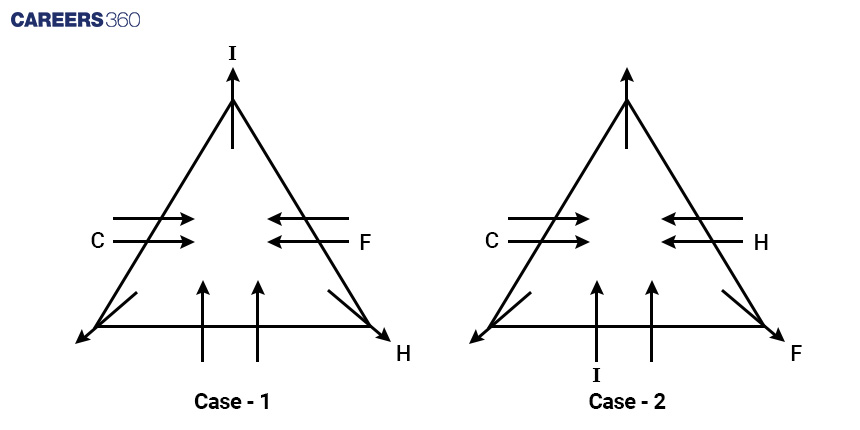
According to the information given above:
1) B sits second to the left of E and vice versa.
2) The number of persons sitting between B and H is the same as the number of persons sitting between C and A when counted from the left of C and right of B.
3)The number of persons sitting between D and F is the same as the number of persons sitting between G and D
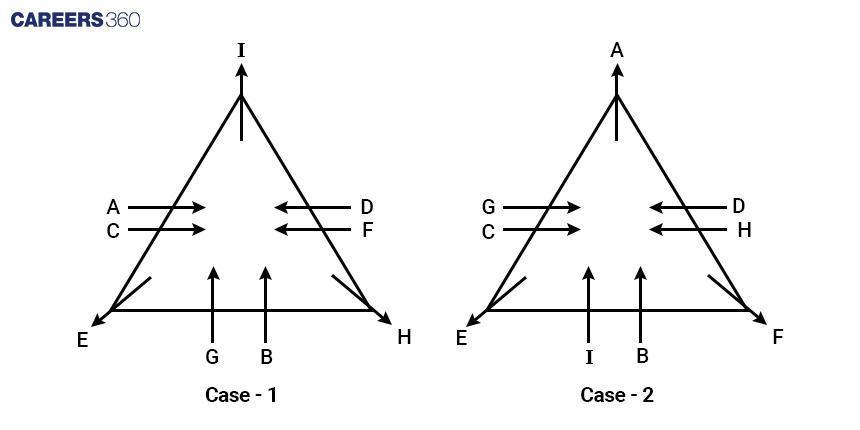 .
.
Therefore, case 1 doesn’t satisfy the above conditions. So, case 2 will be considered the final triangular arrangement.
Thus, the final arrangement is:
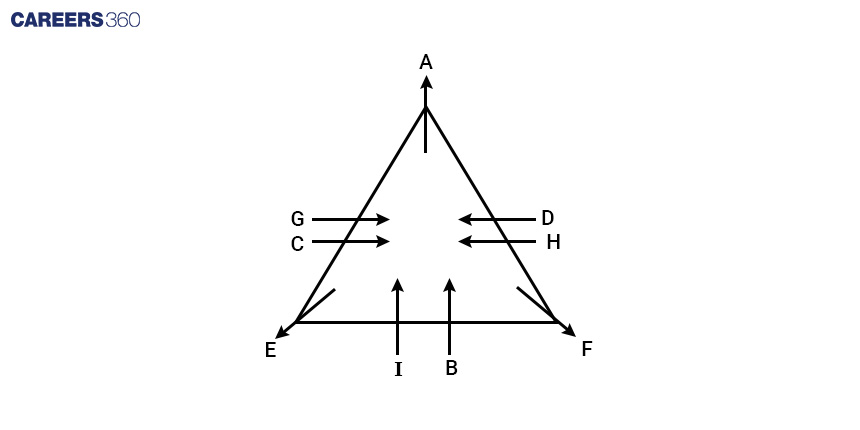
Answer:(1-3)
1) As D is related to H, B is related to I similarly, G is related to C. (Check the order of the alphabets in the clockwise direction. Hence, the first option is correct.
2) A sits at the corner of the table. Hence, the fourth option is correct.
3) As shown in the final arrangement A is at the second position from the left of C. Hence, the first option is correct.
The candidates who are preparing for the upcoming entrance and Government exams can also refer to the links given below and master the reasoning ability section:
Solving Approaches of Puzzle and Seating Arrangement Reasoning Problems
1) Learn the basic approach for circular, rectangle/square and triangle-based puzzles that is when the persons face towards the centre the clockwise direction is the right side of the person, an anticlockwise direction is the left side of the person and when the person faces outside/ away from the centre the clockwise direction is the left side of the person and an anticlockwise direction is the left side of the person.
2) Don’t get confused in the clockwise and an anticlockwise direction. You can check the left or right side of the person with the movement of your hands as well. When a person is facing the centre or outside the centre check the position of your hands to determine the left side and the right side.
3) Read the information carefully and write down every possibility so that in the end your arrangement will be finalised easily.
4) Don’t panic by the length of the puzzle you have to attempt. Read carefully and write down all instructions accordingly which allows you to arrange the persons in the said form easily.
5) The only method to attempt a seating arrangement-based puzzle is to attempt or practice as many questions as you can.
Note: The candidates must practice the seating arrangement reasoning questions pdf, seating arrangement reasoning questions with answers pdf, seating arrangement reasoning mock test, circular seating arrangement reasoning questions, floor seating arrangement reasoning questions etc available online to ace the topic seating arrangements.
Solved examples of Seating Arrangement
1) Directions: Five students are standing one behind the other in the playground facing the instructor. Malini is behind Anjana but in front of Gayathri. Meena is in front of Shena but behind Gayathri. What is the position of Meena?
1) Second from last
2) Extreme first
3) Extreme last
4) Second from first
Solution:
According to the given statement, Malini is behind Anjana but in front of Gayathri. So, the arrangement is –

Also, Meena is in front of Shena but behind Gayathri. So, the arrangement –
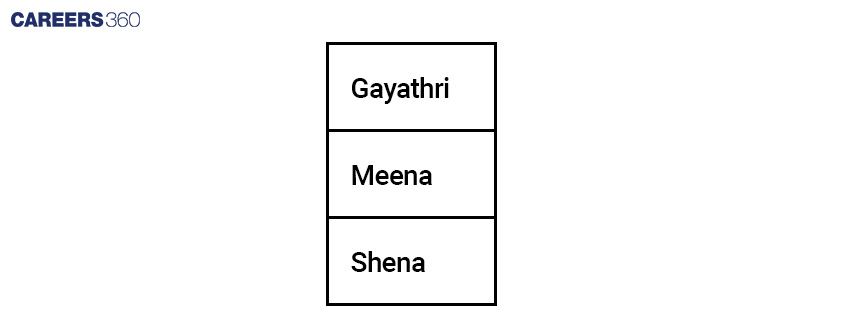
The final arrangement –
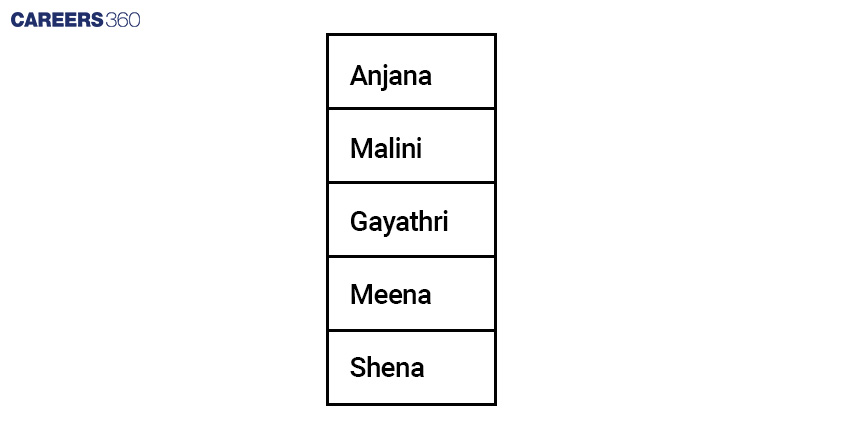
So, Meena is second from the last. Hence, the first option is correct.
2) Directions: Six persons are sitting in a circle. A is facing B, B is to the right of E, and left of C. C is to the left of D. F is to the right of A. Now D exchanges his seat with F and E with B. Who will be sitting to the left of D?
1) D
2) E
3) A
4) B
Solution:
Given:
(I) A is facing B, B is to the right of E and left of C.

(II) C is to the left of D. F is to the right of A.
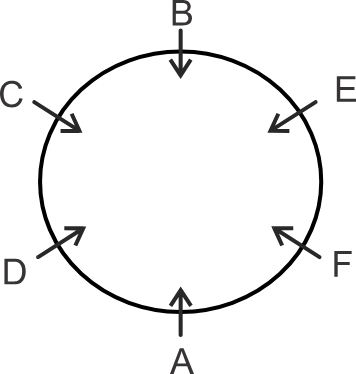
(III) Now, D exchanges his seat with F and E with B.

So, from the above, A is sitting to the left of D. Hence, the third option is correct.
3) Directions: Five girls are sitting in a row. A is on the right of B, E is on the left of B, but to the right of C. If A is on the left of D, who is sitting in the middle?
1) E
2) B
3) A
4) C
Solution:
Given:
Let all the girls face in the north direction.
(I) A is on the right of B, E is on the left of B, but to the right of C.

(II) A is on the left of D.

So, B is sitting in the middle of a row. Hence, the second option is correct.
4) Directions: Six friends are sitting in a circle and facing the centre of the circle. Runa, Charu, and Pari are females. Varun, Manu and Prakash are males. Manu is between Varun and Prakash, and Charu is between Pari and Runa. Varun and Pari are opposite to each other. The person sitting to the right of Runa is male. Who is sitting immediately right next to Prakash?
1) Manu
2) Charu
3) Pari
4) Varun
Solution:
Given:
(I) Runa, Charu, and Pari are females. Varun, Manu and Prakash are males. Charu is between Pari and Runa. Varun and Pari are opposite to each other. The person sitting to the right of Runa is male.
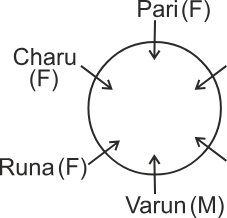
(II) Manu is between Varun and Prakash.
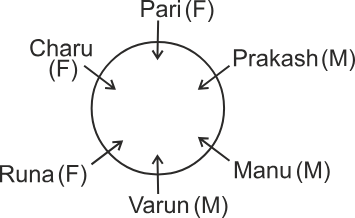
So, Pari is to the right of Prakash. Hence, the third option is correct.
5) Directions: If P is sitting second to the left of S and Q is sitting third to the right of R. T sits immediate right of S, Q is not on the immediate right or left of S. Who is sitting on the immediate right of R?
1) T
2) S
3) P
4) Q
Solution
Given:
Let all the members face north direction.
(I) P is sitting second to the left of S. T sits immediately right of S.

(II) Q is sitting third to the right of R. Q is not on the immediate right or left of S.

So, the immediate right of R is S. Hence, the second option is correct.
6) Directions: Four friends are playing carrom and sitting on the four sides of the carrom board. B is to the right of C. D is to the left of A. Who is sitting to the left of C?
1) Data is inadequate
2) A
3) D
4) B
Solution:
Given:
(I) Four friends are playing carrom and sitting on the four sides of the carrom board.

(II) B is to the right of C. D is to the left of A.
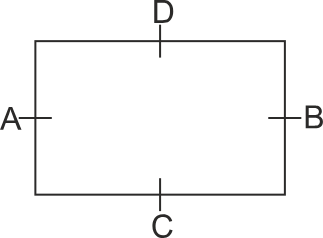
So, A sits immediately left of C. Hence, the second option is correct.
7) Directions: 6 boys, J, K, L, M, N, and P, are sitting around a rectangular table facing towards the centre (not necessarily in the same order). 4 boys are sitting in the corners, and 1 boy is sitting in the middle of each shorter side of the table. N is second to the right of K and second to the left of J. M is exactly opposite to N, and M is not sitting in the corner. Which of the following statements is definitely correct?
I. L and P are both next to N.
II. K is diagonally opposite to L.
1) Only II is correct
2) Neither I nor II is correct
3) Both I and II are correct
4) Only I is correct
Solution:
Given:
(I) N is second to the right of K and second to the left of J. M is exactly opposite to N, and M is not sitting in the corner.
According to the given statements –
I. L and P are both next to N – The position of L and P is not fixed but they both come next to N. So, this statement is correct.
II. K is diagonally opposite to L – As shown in the figure, the position of L is not defined. So, this statement is incorrect.
Therefore, only the first statement is correct. Hence, the fourth option is correct.
8) Directions: 8 boys G, H, I, J, K, L, M and N are sitting around a square table facing towards the centre (not necessarily in the same order). Four boys are sitting at the corners and four boys are sitting in the middle of the sides. J is the immediate neighbour of G and H and he is sitting at a corner. M is the immediate neighbour of N and K. L is sitting in the middle of the side. G is not sitting opposite L. N is towards the immediate right of H. Who is sitting diagonally opposite I?
1) L
2) K
3) N
4) J
Solution:
Given:
(I) 8 boys G, H, I, J, K, L, M and N are sitting around a square table facing towards the centre (not necessarily in the same order). Four boys are sitting at the corners and four boys are sitting in the middle of the sides.

(II) J is the immediate neighbour of G and H and he is sitting in a corner. M is the immediate neighbour of N and K. L is sitting in the middle of the side. G is not sitting opposite to L. N is towards the immediate right of H.

Therefore, N is sitting diagonally opposite to I. Hence, the third option is correct.
9) Directions: Eight people are sitting in two parallel rows with four people each in such a way that there is equal distance between adjacent persons. B, C, D, and E sit in the same row facing south. H, I, J, and K sit in the same row facing north. C sits at the extreme left end of their row and is exactly opposite I. H sits to the immediate left of I. K sits at the extreme left end of their row and is exactly opposite D. B sits between D and E. Who sits exactly opposite H?
1) E
2) B
3) D
4) C
Solution:
Given:
(I) C sits at the extreme left end of their row and is exactly opposite I. H sits to the immediate left of I.
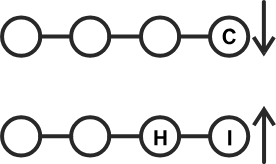
(II) K sits at the extreme left end of their row and is exactly opposite D. B sits between D and E.
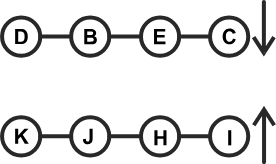
So, E sits exactly opposite H. Hence, the first option is correct.
10) Directions: Seven people P, Q, R, S, T, U, and V are sitting in a straight row, facing north. Exactly three people are sitting to the left of U. R is second to the left of U. Q and V are immediate neighbours of R, such that Q is not an immediate neighbour of U. T and P are not occupying either of the end seats. T is second to the left of S. If P and Q swap their seats, what will be the new position of Q?
1) Second to the right of R
2) Second to the left of V
3) Third to the left of U
4) Second to the right of U
Solution:
Given:
(I) Exactly three people are sitting to the left of U. R is second to the left of U. Q and V are immediate neighbours of R, such that Q is not an immediate neighbour of U.

(II) T and P are not occupying either of the end seats. T is second to the left of S.

If P and Q swap their seats –

So, Q is second to the right of U. Hence, the fourth option is correct.
11) Directions: Six friends A, C, D, E, F, and G are sitting in a straight row, facing north. They are waiting for their seventh friend B to join. Exactly three people are sitting to the left of A. C is occupying an end seat. F and D are immediate neighbours of G. If D is sitting to the immediate left of A, and E is second to the right of A, where will B sit?
1) Fourth to the right of F
2) Fifth to the right of G
3) To the immediate right of E
4) Third to the right of D
Solution:
Given:
(I) Exactly three people are sitting to the left of A. D is sitting to the immediate left of A and E is second to the right of A.

(II) C is occupying an end seat. F and D are immediate neighbours of G.

So, B is the fourth to the right of F. Hence, the first option is correct.
12) Directions: A, B, C, D, E, F, G, and H are sitting around a square table not facing the centre. Some of them are sitting at the corners while some are sitting at the exact centre of the sides. A is sitting to the immediate right of F and immediate left of E. C is sitting to the immediate right of E. G is sitting two places from the right of E. B is sitting to the immediate right of G. H is sitting to the immediate right of B and immediate left of D. D is sitting to the left of F. Who is sitting between A and D?
1) F
2) G
3) H
4) E
Solution:
Given:
(I) A is sitting to the immediate right of F and immediate left of E. C is sitting to the immediate right of E.
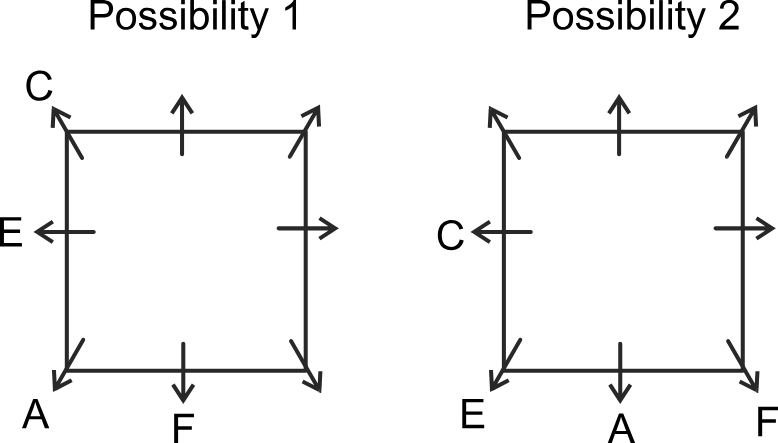
(II) G is sitting two places from the right of E. B is sitting to the immediate right of G. H is sitting to the immediate right of B and immediate left of D. D is sitting to the left of F.
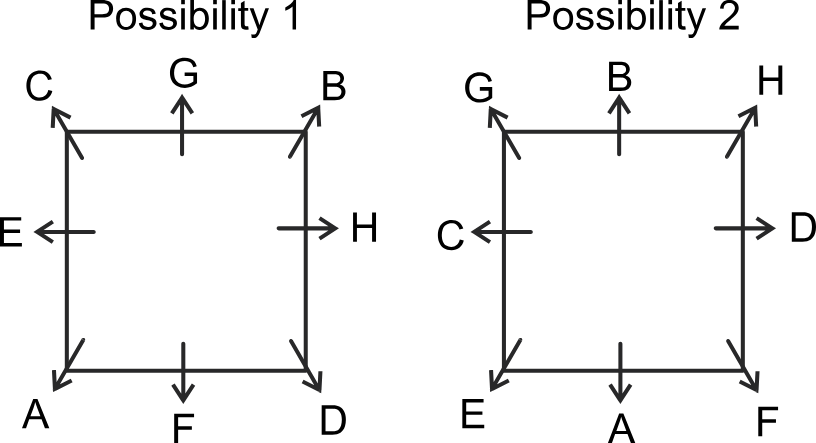
So, in both of the possibilities F is sitting between A and D. Hence, the first option is correct.
13) Directions: Seven people A, B, C, D, E, F and G are sitting in a straight row, facing north. Only two people sit to the right of E. Only two people sit between D and C. G has no neighbours on the left. D is the only neighbour of A. B sits third to the right of G. Who sits third to the right of G?
1) D
2) B
3) E
4) C
Solution:
Given:
(I) Only two people sit to the right of E. G has no neighbours on the left. B sits third to the right of G.

(II) Only two people sit between D and C. D is the only neighbour of A. Only one place is left so this place is assigned to F.

So, B sits to the third to the right of the G. Hence, the second option is correct.
14) Directions: Seven players Virat, Rahul, Rohit, Surya, Hardik, Risbabh, and Deepak are sitting around a circular table facing towards the centre (not necessarily in the same order). Rohit is second to the left of Virat. Virat is fourth to the right of Deepak. Hardik is to the immediate left of Deepak. Surya is not an immediate neighbour of Rohit. Rishabh is second to the right of Hardik. Who is fourth to the right of Hardik?
1) Surya
2) Deepak
3) Rahul
4) Virat
Solution:
Given:
(I) Rohit is second to the left of Virat. Virat is fourth to the right of Deepak. Hardik is to the immediate left of Deepak.
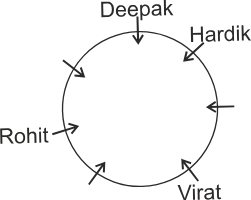
(II) Surya is not an immediate neighbour of Rohit. Rishabh is second to the right of Hardik.
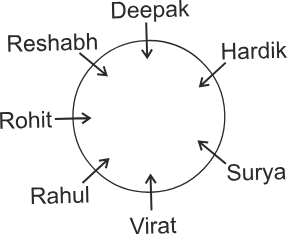
So, Rahul is fourth to the right of Hardik. Hence, the third option is correct.
15) Directions: Ram, Shyam, Pankaj, Tilak, and Gaurav are sitting in a straight line facing south. Tilak and Gaurav are sitting at the ends. Ram is sitting to the immediate left of Gaurav and the immediate right of Pankaj. Who is sitting to the immediate right of Tilak?
1) Shyam
2) Pankaj
3) Ram
4) Gaurav
Solution:
Given:
Tilak and Gaurav are sitting at the ends. Ram is sitting to the immediate left of Gaurav and the immediate right of Pankaj.

So, Shyam is sitting to the immediate right of Tilak. Hence, the first option is correct.
16) Directions: Anuj, Bala, Charanjit, Danish, Endrew, Farooq, Garvit, and Himesh are sitting around a square table facing the centre of the table. Four of them are sitting at each of the corners, while the other four are sitting at the exact centre of each of the sides. Endrew who sits middle of a side, sits to the fourth left of the Garvit. Only one person sits between Garvit and Farooq. Bala is an immediate neighbour of Endrew Only three people sit between Bala and Anuj. Bala is not a neighbour of Farooq. Himesh sits to the immediate left of Charanjit. Charanjit sits to the third right of Endrew. Who sits third to the right of Danish?
1) Himesh
2) Garvit
3) Bala
4) Charanjit
Solution:
Given:
(I) Anuj, Bala, Charanjit, Danish, Endrew, Farooq, Garvit, and Himesh are sitting around a square table facing the centre of the table. Four of them are sitting at each of the corners, while the other four are sitting at the exact centre of each of the sides.

(II) Endrew who sits middle of a side, sits to the fourth left of the Garvit. Only one person sits between Garvit and Farooq. Bala is an immediate neighbour of Endrew
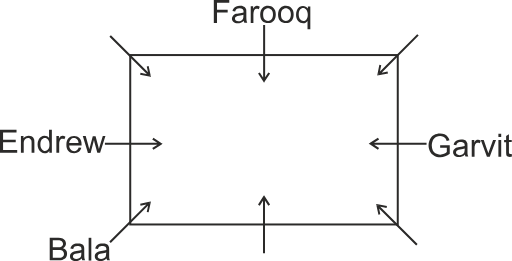
(III) Only three people sit between Bala and Anuj. Bala is not a neighbour of Farooq. Himesh sits to the immediate left of Charanjit. Charanjit sits to the third right of Endrew.
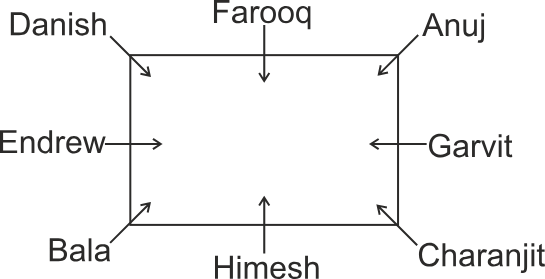
So, Himesh sits third to the right of Danish. Hence, the first option is correct.
17) Directions: In an examination ball seven students Ankit, Chotu, Jitin, Kajal, Nitu, Piyush, and Saksham are sitting in a row facing north but not necessarily in the same order. Chotu sits third to the right of Saksham. Ankit and Piyush are immediate neighbours of Chotu. More than two persons sit between Piyush and Saksham. Jitin is the only neighbour of Nitu. Jitin sits to the right of Ankit. What is the position of Nitu with respect to Kajal?
1) Fifth to the right
2) Fifth to the left
3) Third to the right
4) Third to the left
Solution:
Given:
1. Chotu sits third to the right of Saksham.
2. Ankit and Piyush are immediate neighbours of Chotu.
3. More than two persons sit between Piyush and Saksham.

4. Jitin is the only neighbour of Nitu. Jitin sits to the right of Ankit.
Therefore, the arrangement is as follows –

So, Nitu is fifth to the right of Kajal. Hence, the first option is correct.
18) Directions: A, B, C, D, E, F, G, and H are sitting around a square table facing outwards. Some of them are sitting at the corners while some are sitting at the exact centre of the sides. A is sitting to the immediate left of B and right of H. H is sitting between A and G. F is sitting to the immediate left of G and right of E. D is sitting between E and C. C is sitting to the immediate right of B. Who is sitting between C and E?
1) D
2) B
3) G
4) A
Solution:
Given:
(I) A is sitting to the immediate left of B and right of H. H is sitting between A and G. F is sitting to the immediate left of G and right of E.

(II) D is sitting between E and C. C is sitting to the immediate right of B.
The final sitting arrangement is given below –

So, D is sitting between C and E. Hence, the first option is correct.
19) Directions: Seven girls A, B, C, D, E, F and G are sitting around a circular table facing opposite the centre (not necessarily in the same order). D is second to the right of G. G is third to the right of C. F is third to the right of B. A is not the immediate neighbour of C. E is the immediate neighbour of C. Who is second to the right of A?
1) G
2) C
3) E
4) F
Solution:
Given:
(I) D is second to the right of G. G is third to the right of C.
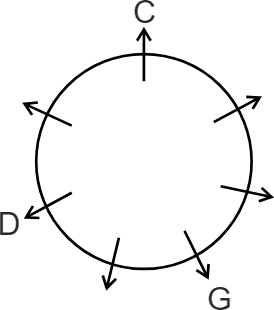
(II) F is third to the right of B. A is not the immediate neighbour of C. E is the immediate neighbour of C.
So, there are two possibilities –
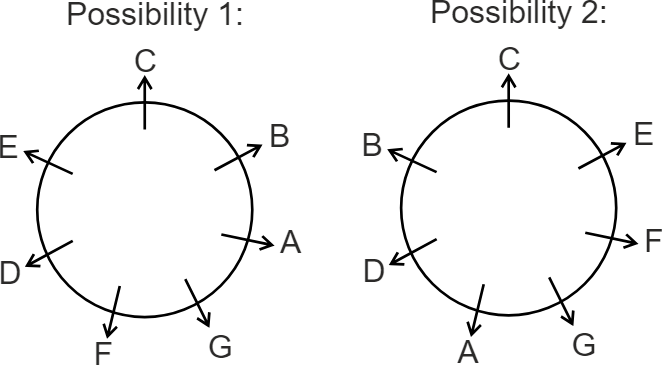
B and F are both second to the right of A. But in the option, only F is given.
Therefore, F is second to the right of A. Hence, the fourth option is correct.
20) Directions: Six people are sitting around a circular table facing the centre. Only D is between P and S. Only X is between M and L. S is sitting to the immediate right of M. Who is sitting immediately right to P?
1) S
2) M
3) L
4) D
Solution:
Given:
(I) Only D is between P and S. S is sitting to the immediate right of M.
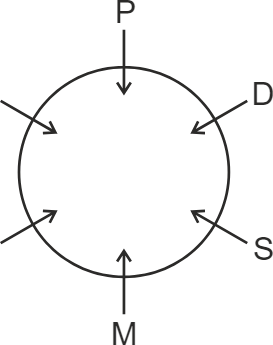
(II) Only X is between M and L.
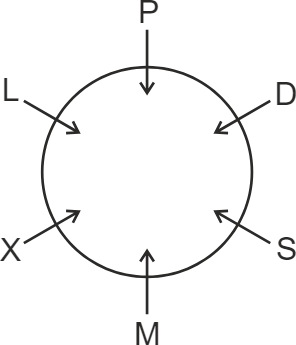
So, L is sitting immediately right next to P. Hence, the third option is correct.
Learn More: For non-verbal reasoning, read the topics below
About the Faculty
Tanu Gupta, with over a decade of experience as a reasoning faculty, specializes in preparing students for various entrance examinations and career development. Her extensive work with multiple educational platforms and institutions has honed her expertise in logical and analytical thinking. Her dedication to innovative teaching methods ensures these articles provide practical insights and expert guidance.
Frequently Asked Questions (FAQs)
Seating Arrangement in reasoning is one of the most important topics in every competitive exam and entrance exam. It is defined as an arrangement of persons/ things in a circle, triangle, rectangle, square, row etc.
There are many types of seating arrangement questions such as linear, circular, square, rectangle, and triangle-based seating arrangements. In the above article, all types are mentioned with examples.
It comes in all competitive exams such as in Bank PO around 15 - 20 questions, in Bank Clerical around 10 - 15 questions, in SSC around 5 - 10 questions and in entrance exams around 2 - 5 questions.
There is only one method to ace the topic practice. So, practice as much as questions you can. If you can grab a technique of arranging the persons in any said type of seating arrangement you can solve any difficult puzzle as well.
As such there is no shortcut to solve the puzzles in the seating arrangement. You have to read the complete information, analyse the information, extract the data and arrange them accordingly to answer the question. You must practice several questions to learn the tricks to solve the seating arrangement.
The most common 3 seating arrangements are linear seating arrangement, circular seating arrangement and Polygonal seating arrangement.